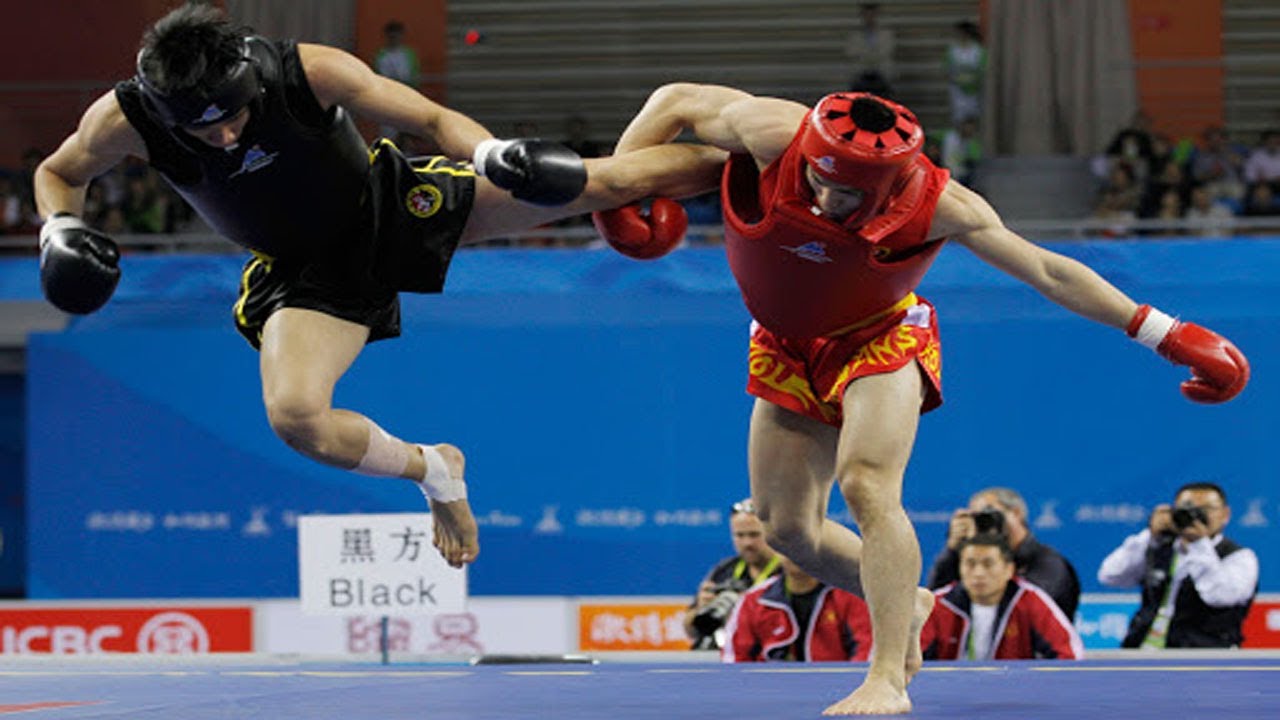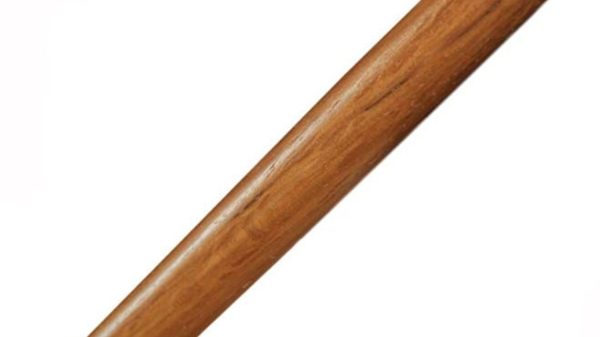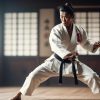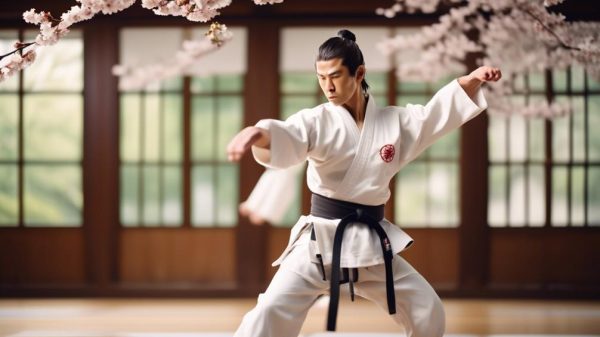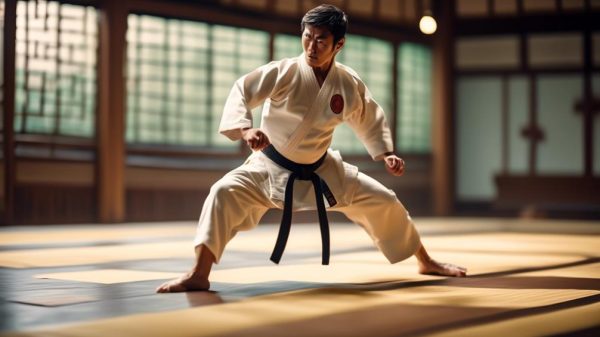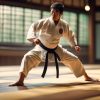Are you ready to challenge yourself and unlock your hidden abilities?
Get set to discover the exciting world of Sanshou martial arts (Sanda). Sanshou helps build your fighting skills. It mixes super quick punches and kicks with strong grappling moves. This lets you handle threats with confidence.
Training in Sanshou takes you on a life-changing journey.
You’ll find and strengthen your true self. You’ll break limits and become a power to deal with.
This remarkable martial art brings out your mind and body’s full power. It lets you reach new levels of strength and skill. Get set to unleash what you’re capable of with Sanshou.

Key Takeaways
- Sanshou is also called Sanda
- Sanshou is a dynamic martial art that develops practical combat skills and techniques.
- It combines striking, kicking, throwing, and grappling moves for well-rounded capabilities.
- Practicing Sanshou builds strength, speed, endurance, reflexes, and mental discipline.
- Training in Sanshou teaches effective self-defense while building confidence.
- Sanshou provides a full-body workout that improves fitness and conditioning.
- Mastering Sanshou requires dedication to learn technical skills and combinations.
- Sparring and competing in Sanshou develops realistic fighting abilities.
- The focus on continuous attacking and defending sharpens reaction time.
- Learning Sanshou martial arts allows students to test their limits.
- Sanshou’s blend of techniques makes it an intriguing martial art to study.
History of Sanshou
The history of Sanshou traces its origins back to traditional Chinese martial arts.
This combat sport combines striking, wrestling, and takedowns to create a dynamic and powerful fighting style.
Sanshou has a rich history that dates back centuries and originated from ancient military training in China. Over time, it evolved by incorporating techniques from various traditional Chinese martial arts like Kung Fu.
The training methods for Sanshou focus on practical application, agility, and explosive power. Practitioners of Sanshou dedicate themselves to developing lightning-fast reflexes, precise striking, and effective grappling techniques.
Through rigorous training, Sanshou fighters become masters of combat, honing their physical and mental abilities.
The history and training methods of Sanshou reflect its deep connection to traditional Chinese martial arts, embodying a spirit of liberation and empowerment.
Sanshou Techniques and Principles
Master the fundamental principles of Sanshou to improve your understanding and proficiency in this dynamic martial art.
Sanshou is a versatile and effective combat system that combines striking and grappling techniques.
Here are some essential techniques for sparring, striking, and grappling that will help you harness the power of Sanshou:
- Sparring Techniques: Takedowns, sweeps, clinching, footwork, and defense tactics.
- Striking Techniques: Punches, kicks, elbows, knee strikes, and palm strikes.
- Grappling Techniques: Throws, joint locks, ground control, submission holds, and escapes.
Training and Conditioning for Sanshou
To improve your performance in Sanshou, incorporate training and conditioning exercises that enhance strength, speed, and agility.
Here are some essential techniques and drills that can help you excel in Sanshou:
- Plyometric exercises: These exercises focus on explosive power and speed. They involve movements like box jumps, clap push-ups, and medicine ball throws, which can improve your ability to generate force quickly.
- High-intensity interval training (HIIT): HIIT is a great way to improve your cardiovascular endurance and stamina. It involves alternating between short bursts of intense exercise and brief recovery periods. You can incorporate exercises like sprints, burpees, and mountain climbers into your HIIT routine.
- Strength training: Strength training is crucial for Sanshou as it helps build overall strength and power. Compound movements like squats, deadlifts, and overhead presses should be the foundation of your strength training routine. These exercises target multiple muscle groups and promote functional strength.
- Agility drills: Agility is a key component of Sanshou, and agility drills can help you develop quick footwork and coordination. Examples of agility drills include ladder drills, cone drills, and shuttle runs.
By integrating these training techniques and conditioning drills into your regimen, you’ll develop the physical attributes necessary for success in Sanshou.
With consistent practice and dedication, you can unlock your full potential in this dynamic martial art.
“Training and conditioning are essential for mastering Sanshou. By incorporating these techniques into your routine, you can enhance your strength, speed, and agility, ultimately improving your performance in the sport.”
Sanshou Competitions and Rules
Sanshou Competitions and Rules: Gain a comprehensive understanding of Sanshou competitions and rules to navigate this dynamic sport.
Participating in these competitions provides practical experience and deeper insights into the application of Sanshou techniques within a competitive context.
Sanshou competitions involve striking and takedown techniques, making it a versatile martial art. The rules focus on scoring points through clean and effective striking, as well as successful takedowns and throws.
By understanding these rules, you can strategize and execute techniques effectively during competitions.
With the increasing popularity of Sanshou in MMA, familiarity with Sanshou competition rules can offer valuable insights for fighters looking to incorporate Sanshou training methods into their mixed martial arts repertoire.
Embracing Sanshou competitions allows you to demonstrate your skills and versatility in a competitive arena.
Benefits of Practicing Sanshou
Unlock the effectiveness of Sanshou through its practicality, versatility, and physical conditioning benefits.
When you engage in Sanshou, you experience a wide range of advantages that go beyond just physical fitness.
Here’s why Sanshou can make a significant impact on your overall well-being:
- Full-body workout: Sanshou’s dynamic movements engage every muscle in your body, providing a challenging cardiovascular workout while improving strength and flexibility.
- Self-defense proficiency: By mastering Sanshou techniques, you develop practical self-defense skills that can be applied in real-world situations. This boosts your confidence and enhances your personal safety.
- Mental resilience: Sanshou fosters mental toughness, discipline, and focus, equipping you with the mindset to overcome challenges both inside and outside the training environment.
- Cross-training advantage: The diverse techniques in Sanshou make it an excellent complement to other martial arts disciplines. By incorporating Sanshou into your training regimen, you enhance your overall skills and adaptability.
Embrace the mental and physical benefits of Sanshou as you embark on a journey of self-improvement through martial arts.
“Practicing Sanshou not only improves your physical fitness but also cultivates mental resilience, self-defense skills, and adaptability. It is a holistic martial art that enhances your overall well-being.”
Famous Sanshou Practitioners
Famous Sanshou practitioners showcase the practicality and effectiveness of this martial art through their remarkable skill and real-world application.
Witness the impressive abilities of these well-known individuals, who have honed their Sanshou training to achieve greatness in the martial arts realm.
Famous Sanshou Practitioners
| Practitioner | Notable Achievements |
|---|---|
| Cung Le | Middleweight Champion in Strikeforce |
| Liu Hailong | Gold Medalist in World Wushu Championships |
| Zhang Weili | Women’s Strawweight Champion in the UFC |
| Muslim Salikhov | World Champion in Combat Sambo |
These renowned Sanshou practitioners have elevated the art form with their unwavering dedication, discipline, and exceptional skill.
Their impressive achievements serve as proof of the effectiveness and practicality of Sanshou, inspiring liberation and empowerment for practitioners worldwide.
Sanshou Equipment and Gear
When it comes to practicing Sanshou, it’s important to have the right equipment and gear. This ensures your safety and enhances your training experience.
Here are the essential items you’ll need:
- Protective Gear: Invest in high-quality headgear, mouthguards, and groin protectors. These will provide the necessary protection during intense sparring sessions.
- Hand Wraps and Gloves: Properly wrapping your hands and using well-fitted gloves is crucial. It protects your hands and wrists when striking and blocking.
- Training Uniform: Wear comfortable and durable Sanshou attire, including a top, pants, and suitable footwear. This allows for fluid movement and agility during training.
- Focus Mitts and Shields: These tools are great for partner drills. They help improve your striking techniques and precision.
Sanshou Vs. Other Martial Arts
When comparing Sanshou to other martial arts, it’s important to evaluate its strengths and weaknesses in order to understand its unique approach and principles.
Sanshou has gained popularity in popular culture due to its dynamic techniques, versatility, and emphasis on practical combat skills.
Unlike some traditional martial arts, Sanshou places a strong emphasis on full-contact fighting and sparring, which provides valuable real-life combat experience.
What sets Sanshou apart is its integration of striking, kicking, and wrestling techniques, making it a comprehensive fighting system.
Additionally, Sanshou offers significant fitness benefits, as it provides a rigorous workout that improves strength, agility, and cardiovascular endurance.
However, it’s worth noting that Sanshou’s effectiveness in self-defense and combat situations may vary compared to more traditional martial arts.
By understanding these distinctions, one can appreciate the sense of liberation and empowerment that Sanshou (Sanda) offers.
Sanshou Sanda for Self-Defense
For effective self-defense in real-life situations, you can rely on the practical combat skills and comprehensive fighting system of Sanshou.
This martial art form offers a range of techniques that can be effectively used for self-defense.
Here’s what makes Sanshou techniques practical for self-defense:
- Versatility: Sanshou (Sanda) incorporates a wide range of striking, grappling, and takedown techniques, providing you with versatile skills to handle different types of threats.
- Realistic Training: Sanshou training involves practical scenarios and simulated attacks, preparing you for the unpredictability of real-life confrontations.
- Adaptability: Sanshou equips you with the ability to adapt to various environments and use everyday objects as defensive tools if needed.
- Effective Counterattacks: Sanshou emphasizes quick and powerful counterattacks, allowing you to efficiently neutralize threats and protect yourself.
With its practicality and emphasis on real-world effectiveness, Sanshou empowers individuals to confidently navigate challenging situations and defend themselves with skill and precision.
Finding a Sanshou School or Instructor
Looking for a Sanshou school or instructor? The key to finding the right Sanshou school is to conduct thorough research.
Look for experienced instructors with a strong background in Sanshou who are dedicated to teaching the art.
Prioritize schools that emphasize practical application and sparring, as these are crucial components of Sanshou training. Additionally, consider the location and class schedule to ensure it aligns with your lifestyle.
When visiting potential schools, observe a class to see if the teaching style and atmosphere align with your goals. Inquire about the curriculum and training approach to ensure it meets your specific needs.
Remember, finding the right instructor is just as important as finding the right school, so take the time to find someone who can effectively guide you.
Frequently Asked Questions
What Are the Common Injuries Associated With Sanshou and How Can They Be Prevented?
To prevent common injuries in sanshou, it is important to focus on proper technique and conditioning.
Additionally, incorporating recovery methods such as rest, ice, and elevation can aid in injury prevention.
By implementing these prevention techniques, you can enhance your performance and maintain a strong and healthy body.
Are There Any Specific Dietary or Nutritional Recommendations for Sanshou Practitioners?
When it comes to maintaining a healthy diet as a Sanshou practitioner, it’s important to focus on a balanced eating plan that provides the necessary fuel for your training.
This means incorporating lean proteins, complex carbohydrates, and healthy fats into your meals. These nutrients will support your energy levels, muscle growth, and overall performance.
In addition to a balanced diet, you may also consider incorporating nutritional supplements to further enhance your training and recovery.
However, it’s crucial to consult with a professional who can provide personalized recommendations based on your specific needs.
How Does Sanshou Training Incorporate Mental Focus and Discipline?
To develop mental toughness in Sanshou, you can focus on concentration techniques. Instead of letting your mind wander, train with intention and stay fully present in each moment.
Visualize success by imagining yourself executing techniques with precision and achieving your goals.
Practice mindfulness by being aware of your thoughts and emotions without judgment, allowing you to maintain focus and react calmly in high-pressure situations.
Cultivate discipline through daily routines and consistent training. By establishing a structured schedule and committing to regular practice, you can strengthen your mind and unleash your power in Sanshou.
Remember, mental focus and discipline are key components of success in this martial art.
Is There a Specific Age Limit for Starting Sanshou Training?
There is no specific age limit for starting Sanshou training. Whether you are a child or an adult, you can benefit greatly from the discipline and focus it offers.
Sanshou is a dynamic martial art that provides physical fitness, self-defense skills, and mental empowerment.
It is suitable for individuals of all ages who are interested in developing these aspects of their well-being. So, regardless of your age, you can embrace the benefits of Sanshou training.
Can Sanshou Be Practiced by Individuals With Physical Disabilities or Limitations?
Yes, individuals with physical disabilities or limitations can practice Sanshou through adaptive techniques and inclusive training practices.
This martial art form provides opportunities for personal growth and learning, promoting inclusivity and empowerment.
Sanshou embraces the idea that everyone, regardless of their physical abilities, should have the chance to participate and benefit from martial arts training.
By modifying techniques and training methods, individuals with disabilities can engage in Sanshou and experience the physical and mental benefits it offers.
It is a testament to the power of martial arts to transform lives and break down barriers.
As the Sanshou community continues to evolve and embrace inclusivity, individuals with physical disabilities can find solace and fulfillment in this ancient practice.

